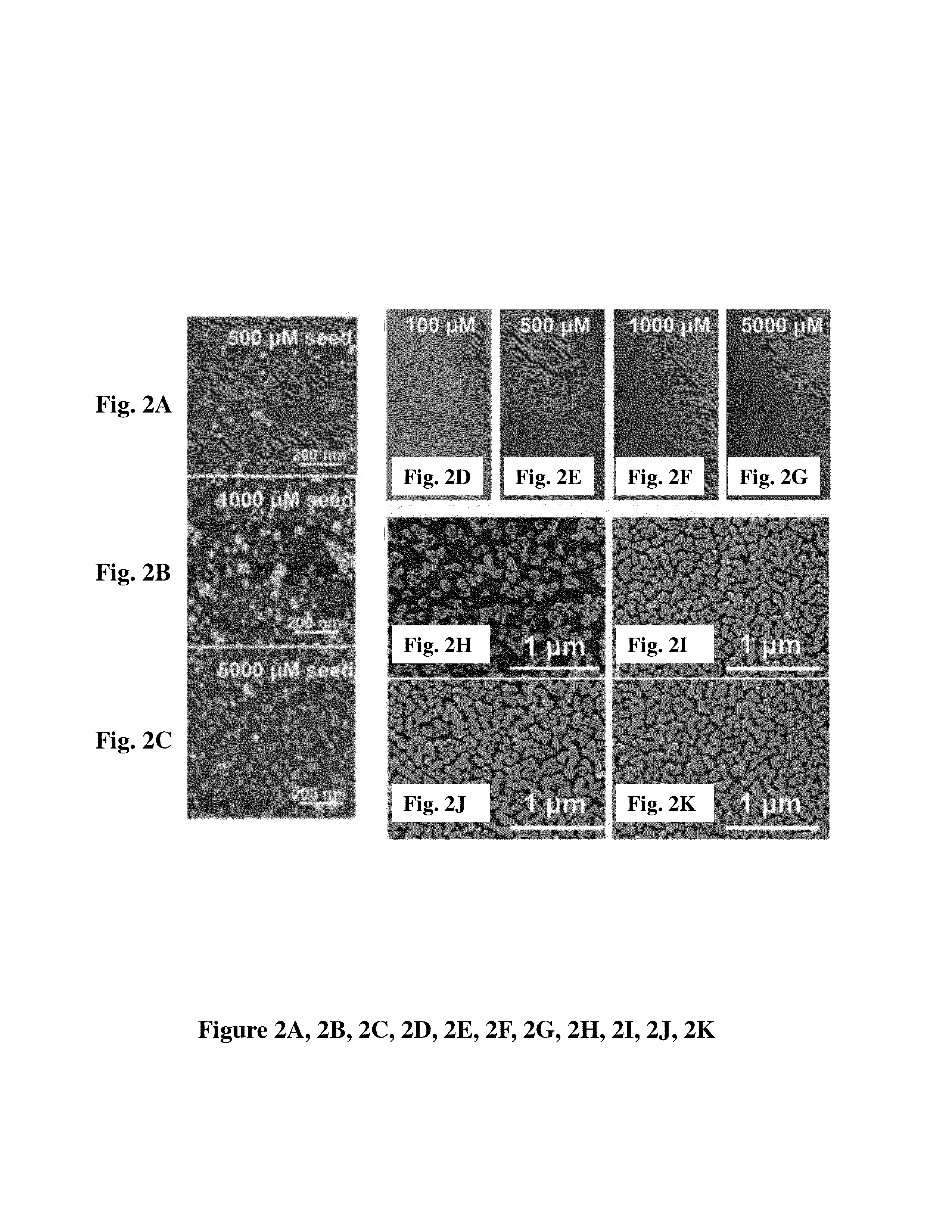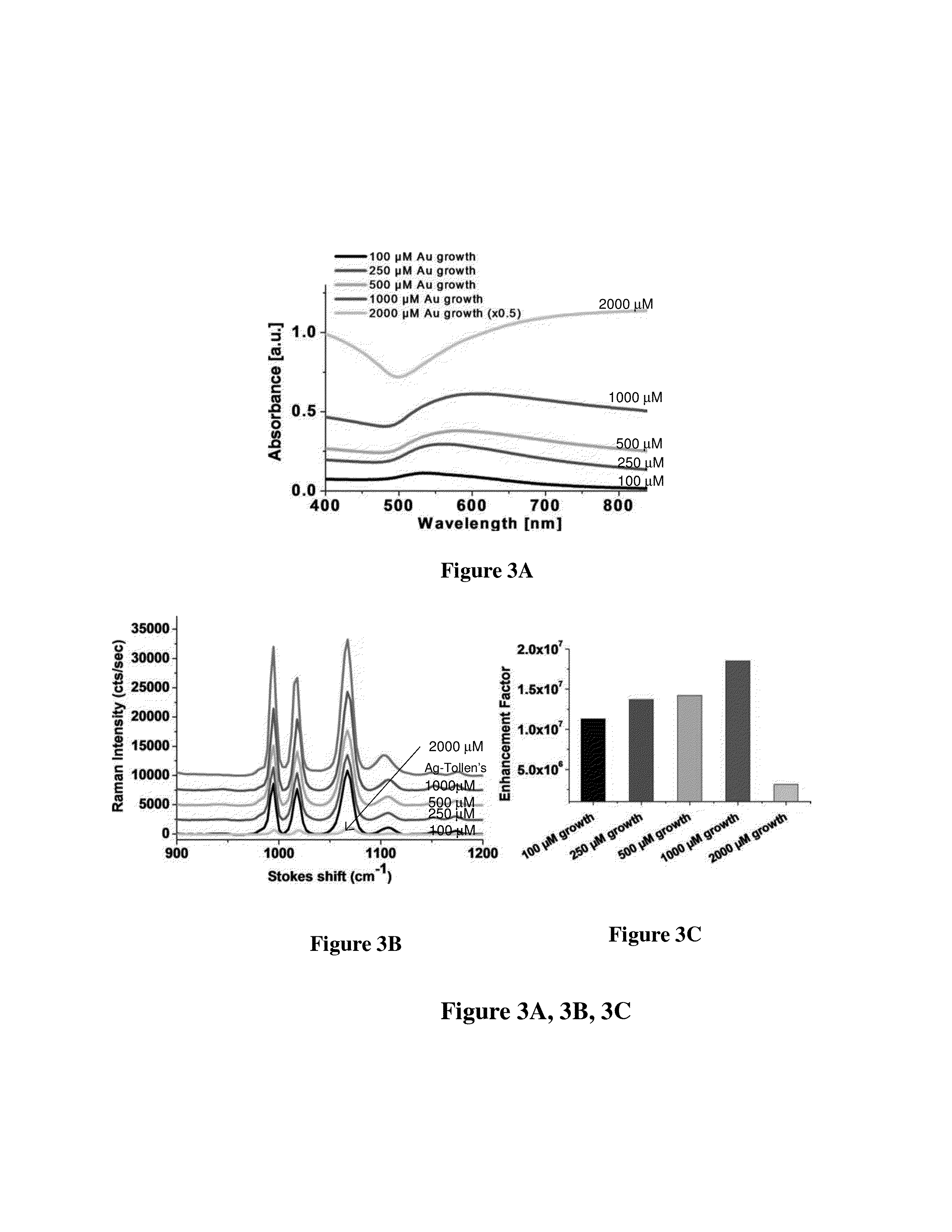Fluorescence enhancing plasmonic nanoscopic gold films and assays based thereon
a technology of plasmonic gold and nano-infrared, which is applied in the field of nano-structured plasmonic metal film formation on substrates, can solve the problems of oxidation and instability problems of ag, the vacuum deposition of gold films and thermal annealing of sers-active substrates is undesirable, and the preparation of highly stable plasmonic gold substrates requires complicated and expensive methodologies and instruments, and achieves the effect of enhancing plasmonic near-infrared flu
- Summary
- Abstract
- Description
- Claims
- Application Information
AI Technical Summary
Benefits of technology
Problems solved by technology
Method used
Image
Examples
example 1
Seeding of Gold Precursors onto Unmodified Substrates
[0177]Preparation of Au / Au films involves three steps: seeding of gold precursors, reduction into Au0 clusters, and selective growth by hydroxylamine reduction of HAuCl4 (FIG. 1). Seeding was accomplished by addition of ammonium hydroxide into a solution of chloroauric acid containing the substrate of choice (see Methods). Immediately following ammonium hydroxide addition, the transparent yellow, acidic HAuCl4 solution became cloudy and orange-yellow, with pH ˜9. The deposition rate of the Au3+ species onto the substrate was found to be rapid. Increased exposure times from one minute to twenty minutes did not significantly affect the density or size of gold seeds immobilized on the substrate.
[0178]Seeding density of Au seeds was dependent upon the initial concentration of HAuCl4 into which the substrate was submerged prior to precipitation by ammonium hydroxide. For inorganic substrates such as glass and SiO2, an increase of HAuCl...
example 2
Solution Phase Reduction of Gold Precipitate Precursors Enables Gold Film Growth
[0179]Following the deposition of Au seeds by precipitation onto the substrate of choice, the substrate was immersed into a 1 mM solution of sodium borohydride, which led to rapid formation of Au0 nanoparticles, evidenced by a faint pink-purple color change of the substrate. Atomic force microscopy revealed formation of Au NPs with diameters of 5-10 nm (FIG. 1b), and UV / Vis absorption spectroscopy revealed a weak surface plasmon resonance at 525 nm, typical of Au NPs in this size range.
example 3
Selective Reduction of Au3+ onto Precursor Au Seeds Yields Plasmonic Gold-on-Gold (Au / Au) Films
[0180]Submersion of the seeded substrate into an aqueous solution of chloroauric acid and hydroxylamine initiated selective reduction of Au3+ onto the seed layer, and thus the Au precursor seeds were grown into plasmonic nano-islands (i.e., “isolated island areas”) (FIG. 1D). Hydroxylamine-mediated gold reduction led to a color change of the substrate from pink to blue-purple, and finally a golden color was observed on the substrate as the film thickened (FIG. 1C). SEM imaging revealed that the Au nano-islands formed on the substrate were separated by ˜10-100 nm gap spacing, a morphology desirable for local electrical field enhancement and SERS.[20]
[0181]The resulting Au / Au film thickness and structure depended on both the density of gold precursor seeding and the concentration of Au3+ ions during hydroxylamine-mediated growth. At a “growth” concentration of 500 uM HAuCl4, a substrate seed...
PUM
 Login to View More
Login to View More Abstract
Description
Claims
Application Information
 Login to View More
Login to View More - R&D
- Intellectual Property
- Life Sciences
- Materials
- Tech Scout
- Unparalleled Data Quality
- Higher Quality Content
- 60% Fewer Hallucinations
Browse by: Latest US Patents, China's latest patents, Technical Efficacy Thesaurus, Application Domain, Technology Topic, Popular Technical Reports.
© 2025 PatSnap. All rights reserved.Legal|Privacy policy|Modern Slavery Act Transparency Statement|Sitemap|About US| Contact US: help@patsnap.com



